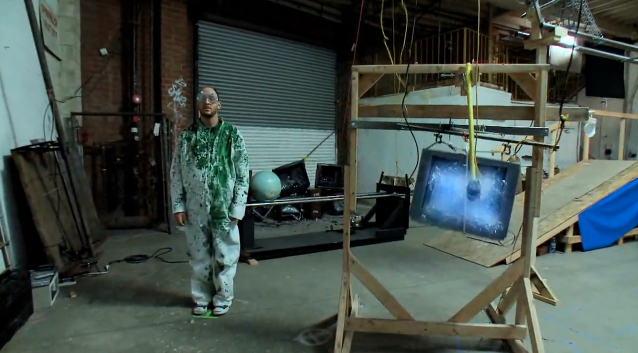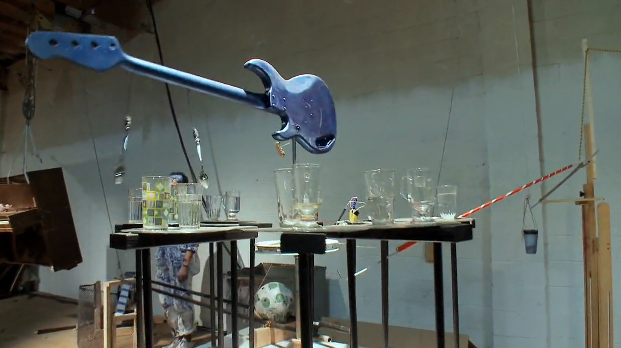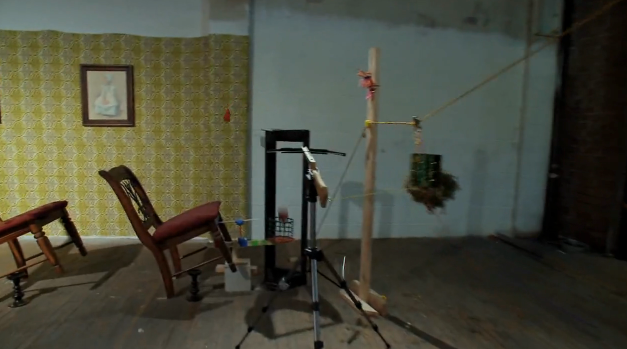In the last 48 hours an amazing video has swept the net. The OK Go “This Too Shall Pass” music video – built and engineered by a creative geek group of mad scientists, art lovers, and inspired geniuses that collectively go by the name of Syyn Labs. As Adam Sadowsky, of Syyn Labs, was getting a haircut and about to go on national television as a result of the video’s enormous success, he spoke to fxguide’s Mike Seymour about the naive contraptions of sheer brilliance that make this Ok Go music video one of the most engaging viral videos of the year.
The video features a huge Rube Goldberg machine which is a deliberately over-engineered machine that performs a very simple task in a very complex fashion, usually including a chain reaction as was the case in the “This Too Shall Pass” video from Ok Go’s new album, Of the Blue Colour of the Sky. Ok Go shot to fame for their famous ‘dancing on treadmills’ video “Here It Goes Again” on YouTube
In the video the entire “This Too Shall Pass” song is sung while a set of mechanical ‘dominos’ fall – in a more complex and home brew version of the Honda ‘Cogs’ TV spot done a few years ago. It is little wonder at the massive downloads the OK Go video is receiving on Youtube. The piece is engaging, enchanting and wholly unbelievable if it were not shown in one uninterrupted take. Syyn Labs built the machine and is itself part Improv now, part performance artists, part mad scientists.
To find out more we asked Sadowsky just how Syyn Labs got started.
Syyn Labs is a group that evolved from a monthly event called Mindshare LA. The original Mindshare LA was started about two and a half years ago as a networking group of forty or fifty people who wanted to share ideas and explore a range of issues in downtown LA. Initially the group held talk nights once a month on everything from “belly dancing to biology, to psychology… or whatever,” explains Sadowsky.
The group, over time, started to do regular nights with a group of technology artists, who liked to make elaborate installations or alternative experiences. “We loosely called that group the Mindshare Labs group,” he adds, “in the last month or so we have formalized this group into the Syyn Labs…and Syyn Labs is the group which built this machine for the music video. We are a group of about 25 or so very talented engineers, computer scientists and artists of all kinds…and so when the band put it out there what they wanted, we submitted a proposal and they loved it – so we got to work together.”
In total some 65 people worked to build and film the machine. What is remarkable is that the project took over the old warehouse space on November 9th, 2009 and did not start filming until February 11, 2010. To reset the machine took up to an hour and it needed to be reset over 60 times, as it took over 60 takes to get one perfect hero filmed version.
To make matters even harder the machine needed to play out in time to the song. The team looked initially at building in retiming elements such as adjustable ramps so that some computer controller could adjust the speed of the action, but the team dropped this approach as it seemed unnecessary complicated.
Instead, the team decided to make every event or action of the Machine “something my mother could understand” and make it all very low tech. Of course the naive appearance of each action really hid the vast complexity of being able to time out the entire piece. This balance of complexity and simplicity was a fine path to walk. “In one case in particular, we had 26 interactions in 17 seconds and it was just too fast – so it would have been hard to follow.”
As the machine was built on the second floor of a building in Echo Park on Glendale Blvd., another problem the team had was the unexpected interaction of some of the events, for example, the piano was changed to be a much more violent fall, which in turn accidentally triggered other events prematurely and that meant yet another take. This resulted in having to have off camera staff to make sure the whole machine did not run away ahead of schedule.

The piano drop alone tended to trigger off an offshoot or tangent interaction – one that did not directly lead to another event but provided additional aesthetically beautiful content. This second or tangent event was intended to fire some cans. To avoid them misfiring their sensitivity was adjusted to make them more robust – but this meant that the final take in the music video missed having these can’s actually ever fire – but as the interaction was only a tangential one – it was decided that it was not worth re-setting and going again for with yet another take.
The project was filmed on an EX-3 camera on a Steadicam rig. The last take was actually filmed at 2am, proving that massive patience, painstaking science and rock ‘n roll can really live together successfully. A nice touch in the video, given the huge amount of work contributed by Adam and the Syyn Labs team, is a final pan up to the crew above the band at the end.
And for those of you wondering – the machine was dismantled BUT this Friday parts of the machine will be installed at the Los Angeles County Museum of Art (LACMA) where the band will play an acoustic set, and Syyn Labs will answer some Q&A from fans of the band and the video.
OK Go Video Release Party 03/05/10 Ticket Information: $20 LACMA Muse, LACMA Members, Mindshare L.A. members. OK Go will perform a rare acoustic set on the terrace of the LACMA West Penthouse. There will be a special screening of the “This Too Shall Pass” video along with past OK Go videos, followed by a Q&A with the band. The night will also feature a DJ set by Tim Nordwind and pieces of the Rube Goldberg machine custom built by Syyn Labs for the “This Too Shall Pass” video will be on display.



[…] fxguide quick takes » Ok Syyn Labs Go…Adam Sadowsky – http://www.fxguide.com/qt/2259/ok-syyn-labs-go-adam-sadowsky – http://www.GetShawty.com […]
I love this spot, it’s so inventive and pushes this style further than anything before. However I do wish you would get the references right. All of this work stems from the fischli and weiss work from the 80’s called ‘how things go’.
The OK GO work is possibly the closest in spirit to this, but adds performers
the mix, with fantastic results.